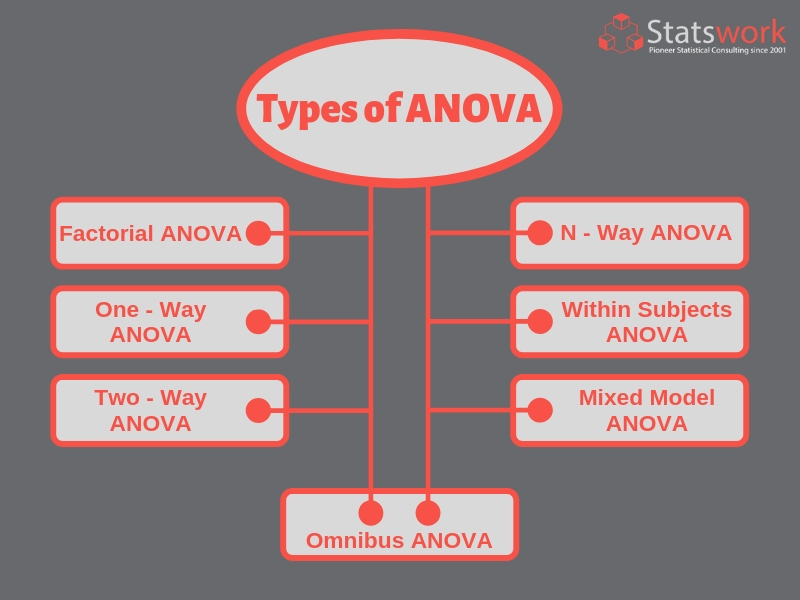Analysis of variance (ANOVA)
ANOVA is a statistical tool used for comparing statistical groups using the dependant and the independent variables. Analysis of variance (ANOVA) is a technique that uses a sample of observations to compare the number of means. ANOVA calculates statistical differences between two or more means for either groups or variances. The measured variables are called dependent variable e.g. Test score, while the variables which are controlled are termed as independent variable e.g. Test paper correction method.
Statswork is one among the country’s leader in providing Data Analysis and Statistical Consulting Services. Contact Statswork for availing our services.
Analysis of variance
Analysis of variance (ANOVA) is a statistical technique which is used to compare datasets. It is commonly referred as Fisher’s ANOVA or Fisher’s analysis of variance. It is similar to that of t-test and z-test, which are used to compare mean along with relative variance. However, in ANOVA, it is best suited when two or more populations/samples are compared. Researchers and students use ANOVAs according to their research needs. The three commonly used ANOVA are One-way ANOVA, Two-way ANOVA, and N-way ANOVA

Different Types Of ANOVA
Factorial ANOVA
This type of ANOVA show whether a combined independent variable can predict the value of the dependent variable. In one-way ANOVA, only a single factor is examined using the effects of different levels. Factorial ANOVA, on the other hand, allows you to understand the interactions between factors instead of requiring two different sets of experiments to determine the effects of the two factors. This ANOVA can use random numbers to design the factors.
One – Way ANOVA
One-way ANOVA compares levels of a single factor i.e. one independent variable over the dependent variable.
Two – Way ANOVA
Two-way ANOVA is used to compare two or more factors i.e. effect of two independent variables on a single dependent variable. This can be used in understanding the interaction between the two independent variables. Both types of ANOVA have a single continuous response variable.
N – way ANOVA
Data classified in multiple independent variables are used in an N-way analysis of variance for example differences in age and gender can be checked simultaneously using two-way ANOVA. The N-way ANOVA can show whether there are effects of the independent variable and interactions between them. Interactions are usually seen when one independent variable depends on the second independent variable.
Within-Subjects ANOVA
Within-subject, ANOVA are factors where the same subjects are compared under different conditions or levels. These levels can be measurements for the same size. They can also be reiterations of the same outcome over time.
Mixed Model ANOVA
A combination of Within-unit ANOVA along with Between-unit ANOVA gives us a Mixed-unit ANOVA. It consists of at least two independent variables. One of these variables must vary with Between-unit ANOVA and one has to vary with Mixed-unit ANOVA.
Omnibus ANOVA Test
There is no significant difference in the groups which is the null hypothesis for an ANOVA. The other hypothesis states that there will be at least a single difference among the groups considered. The researcher must test the assumptions of ANOVA. After finding the data, F-ratio and the p-value must be calculated. If the p-value associated with F-ratio is smaller than 0.5 then the null hypothesis is rejected and the other hypothesis is given prominence. This means that the mean of all groups is not equal. After this, the researcher should consider doing the Post-hoc test to understand which groups are different from each other. Post- hoc test helps to identify errors and later places the items in a group.
F-Tests
The test is simply a ratio of two variances. Variances are a measure of how far the data is scattered. It is based on the population of the mean squares which is an estimate of the population variance.
T-Test
It is a test that determines whether there is a difference between the means of two groups which may have certain identical features. Mostly used in data set where flipping a coin or dice 100 times would be followed by distribution having unknown variances. It is a Hypothesis-testing tool and assumptions are tested using it.
Homogeneity Of Variance
It is an assumption where there are population variances in both T-tests as well as F-tests of two or more samples, which are equal.
Welch and the Brown-Forsythe Test
In certain cases, the variances cannot be assumed to be equal and at this juncture, the F test of ANOVA is not suitable so this is when Welch and the Brown-Forsythe test come into effect. The test adjusts the denominator of the F ratio and it has the same expectancy of the numerator when the null hypothesis is true.
- Top 10 Machine Learning Algorithms Expected to Shape the Future of AI
- Data-Driven Governance: Revolutionizing State Youth Policies through Web Scraping
- The Future is Now: The Potential of Predictive Analytics Models and Algorithms
- 2024 Vision: Exploring the Impact and Evolution of Advanced Analytics Tools
- Application of machine learning in marketing
